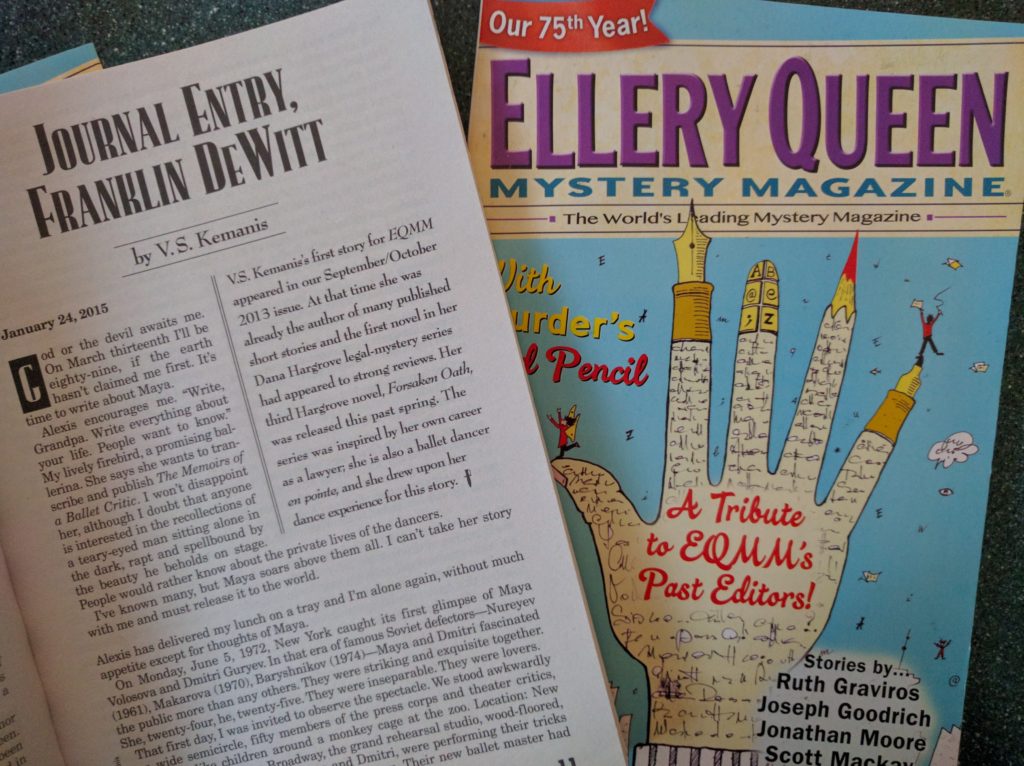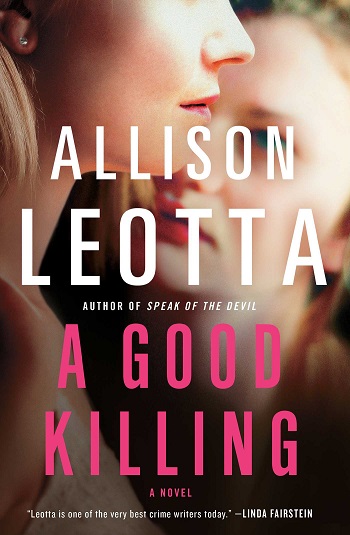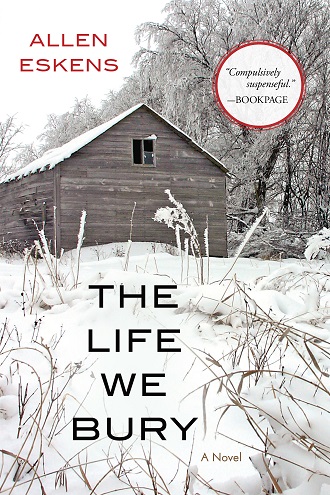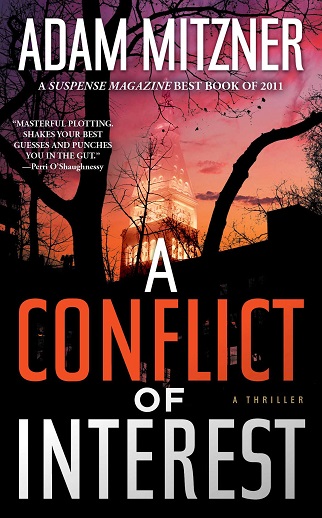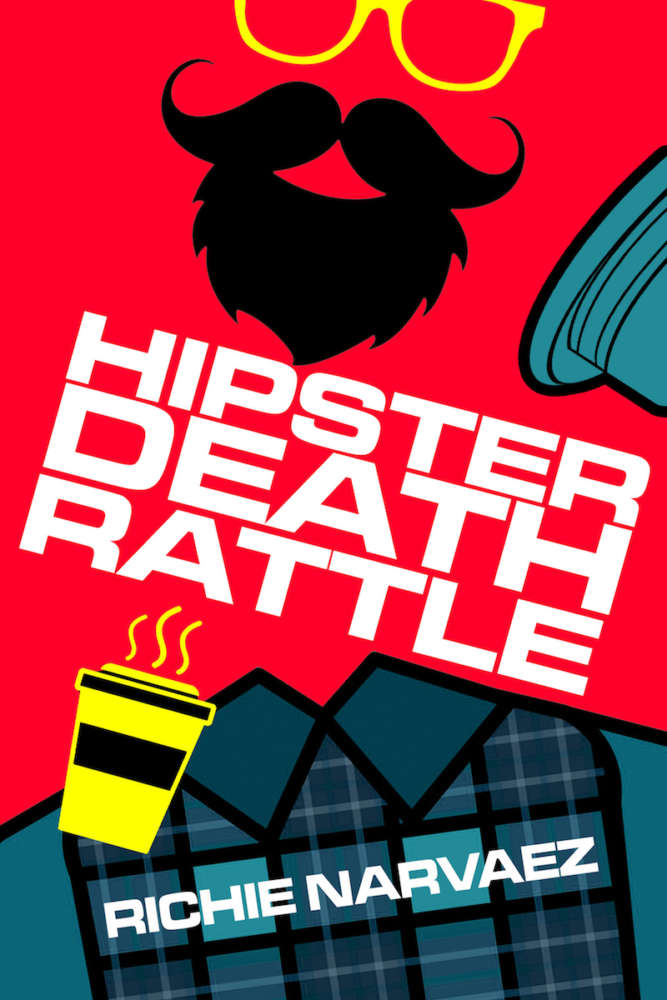
For this installment of Fiction Favorites and Awesome Authors, I’m delighted to welcome author Richie Narvaez to VBlog for a conversation about his recently released debut novel.
The title alone piques your interest, doesn’t it? And how about that cover art by JT Lindroos? Very eye catching. But more important: This is a debut novel not to miss.
If you like crime fiction and want something different and unique, this is for you, especially if you live, or have ever lived, in New York City. To avoid spoilers, I won’t give away any more of the plot than what’s in the publisher’s blurb:
Murder is trending. Hipsters are getting slashed to pieces in the hippest neighborhood in New York City: Williamsburg, Brooklyn. While Detectives Petrosino and Hadid hound local gangbangers, slacker reporter Tony Moran and his ex-girlfriend Magaly Fernandez get caught up in a missing person’s case—one that might just get them hacked to death.
Filled with a cast of colorful characters and told with sardonic wit, this fast-moving, intricately plotted novel plays out against a backdrop of rapid gentrification, skyrocketing rents, and class tension. New Yorkers and anyone fascinated with the city will love the story’s details, written like only a true native could. Entertaining to the last, this rollicking debut is sure to make Richie Narvaez a rising star on the mystery scene.
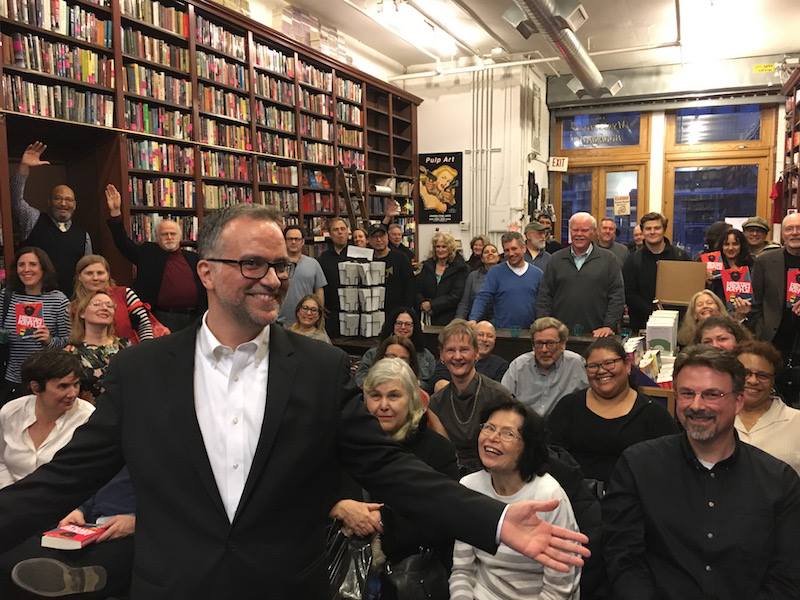
I was fortunate to attend the launch party for Hipster at the Mysterious Bookshop in Manhattan, where the author treated us to a reading of the first few pages. His lively and vivid writing was made even more so by his spot-on delivery and timing. Let’s hope that an audio book narrated by Narvaez himself is in the future.
The novel features a large cast of characters, people from all walks of life and many ethnicities. From a lesser author this might pose a problem, but Narvaez has a knack for making his characters memorable. They come alive on the page through quirky physical traits, dialogue and actions, details about where they live, what they eat, what stores they patronize, and the pets they own. In one scene, for example, a seven-month pregnant thirtysomething yuppie named Erin and her husband Steven (for whom she has endless cutesy nicknames such as “Stevely,” “McSteven,” and “Steve-o-rini”), dine at a new Burundian restaurant in Williamsburg and, slightly nauseated from the Burundian bananas and beans, return to their condo in an upscale, glittering glass tower with river view, where Erin smartly thanks her Mexican doorman with a “Gracias,” confident in the perfection of her Spanish accent because she actually once had a Mexican friend in Texas who complimented her on it. I was laughing.
As you may guess from the book blurb, there are, indeed, machete slashings in Hipster, but if excessive gore gives you nightmares (as it does for me), rest assured that the bloody details are kept to a relaxing minimum, leaving the reader to use his or her imagination, as desired. In the context of the murder mystery and police investigation, social commentary about gentrification and ethnic tensions is expertly woven into the plot in a non-preachy, entertaining way. The author gives us, for example, the dying thoughts of some of the victims, which invariably include emotion-laden regrets about the imagined fate of their apartments after they die. It’s hilarious, but at the same time, a statement about the universal preoccupation of New Yorkers with housing and real estate.
And now, I’m pleased to say that the author has graciously agreed to answer some of my burning questions.
Welcome to VBlog, Richie. I thoroughly enjoyed Hipster Death Rattle. Social commentary figures prominently in your novel, enhancing, never detracting from, the story line and characters. What led you to incorporate this theme into a murder mystery as opposed to, say, a literary or mainstream novel, and what do you see as the advantages of this format?
Ah, well, I did originally try to write Hipster as a mainstream book, but it was too close to me and I stumbled. I couldn’t get past my own bitterness about gentrification in Williamsburg, and all the characters were just talking points, not people. I needed a plot to anchor my pain and my ideas.

And that’s the thing about genre writing isn’t it, the thing that drives literary or mainstream snobs mad: it’s got plot! I could’ve done this as a horror or sci fi novel, but crime fiction is the most grounded of the so-called genres, and I wanted this story to have literal resonance, not metaphorical. And crime fiction is a very flexible format—flexible as a dancer! You ignite the story with the mystery, and the process of its being solved allows the protagonists and the reader to encounter people and points of view.
Of course some readers would prefer to have their corpses served without a side of social commentary, so I may lose those readers. But many of the greats—Christie, Chandler, Highsmith, Paretsky—have social commentary in their works. Crime fiction is actually a perfect vehicle for social commentary.
I knew there was a reason I keep dancing—to make my crime fiction better! As for the flexibility of the genre…maybe this book was therapy or vicarious payback for you? (“Lolz,” as your character Gabrielle likes to say.) “No one there is who loves a hipster,” whispers the murderer as he comes upon his next victim. How much of this is personal for you, based on your experience, witnessing the gradual transformation of the neighborhood of your youth?
It’s all very personal. I was born in Greenpoint Hospital and raised in Williamsburg, Brooklyn. I went away for college, but then returned to witness the rise of gentrification. Slowly, gradually, I saw people displaced, many of my friends and relatives, and I saw the disrespect and erasure of the culture of the people who had lived there for so long.
To be clear, gentrification is not a natural process. Yes, neighborhoods change hands all the time, but gentrification is different, it’s insidiously manufactured, a combination of real estate developer and governmental cunning, urban renewal for profit, not for people.
I’m not sure how much payback there is in writing the book. The Powers that Be would likely not take notice, and they will likely never be punished for their greed. But, therapy, yes, a little. Although the pain does not go away completely. It just feels better for a little while.
Carpe diem, Richie. My Latin is a little rusty, but…
Hah! Habeas corpus and obiter dictum!
Touché! Yes, we lawyers tend to sprinkle in the Latin and forget that it isn’t English. But I did learn some new non-legal Latin from your book. I like the way you worked it into the dialogue between Chino and his former college professor and bad guy, Litvinchouk. We understand most of it in context, and it adds a lot of humor to their relationship. How did this idea come about?
The Latin thing came ab initio from the fact that the person I partially based the character of Chino on actually did minor in Latin in college. So at first it was just a neat character detail, and it allowed me to spend hours learning some very basic Latin myself. But then I realized it added some irony. People hate hipsters for being snobby. Yet, here is a main character who holds on to and cusses in a dead tongue, a language darling to the elite and the intellectual. Also, Chino is a Latino who can speak Latin but not Spanish, underlining his separation from his own culture, Othering him to underscore his status as another kind of hipster himself.
What are your tips for writers who want to incorporate irony and humor into their writing? Or does this just come naturally to you and woe to us?
I have to say the humor seems to come fairly naturally for me. A genetic quirk. Or the legacy of a sensitive childhood. Although, I have to say, in the first draft of Hipster there was no humor. I was trying to be a serious crime writer and write seriously about a serious subject. But I realized I wasn’t very satisfied with that, and it kind of bored me. So I went back and added in the funny.
Now, it’s difficult to tell someone how to be funny and ironic. Not taking yourself too seriously is key. And I will say the chief tool to use is surprise. Humor and irony come out of the unexpected. So, as you’re writing along, stop and think about what everyone expects will happen or be said next, and then do the opposite or at least sideways, something silly and/or something that resonates with the theme of what you’re trying to say. In any case, don’t give the readers what they expect.
Good advice for writers, but I won’t allow you to thwart something I’m expecting from you: more great writing. What’s next? What’s on your computer screen these days?
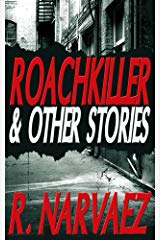
Littering my desktop are several short stories in various stages as well as a novel, but that seems to be a permanent state of affairs for me. At the moment I’ve got a YA novel making the publisher rounds. And there’s a second book of short stories, to follow Roachkiller and Other Stories, I hope to have out next year.
Best of luck on all these endeavors, Richie. I look forward to reading your next book.
Dear Readers,
You can get Hipster Death Rattle from Down and Out Books (see also links to booksellers on the Down and Out Books site), and at the Mysterious Bookshop.
After reading Hipster, if you’re looking for more good summer reading, I’ve built up quite an archive of book reviews and author Q & As. Click the VBlog tab, and then, on the sidebar, “Fiction Favorites and Awesome Authors” or “Legal Eagles” (my series on attorneys writing fiction). You will find articles on books by all of these amazing authors and more: Kevin Egan, Nancy Bilyeau, Manuel Ramos, Allison Leotta, Adam Mitzner, Kate Robinson, David Hicks, Helen Simonson, Eowyn Ivey, William Burton McCormick, and Allen Eskens.
Happy reading!

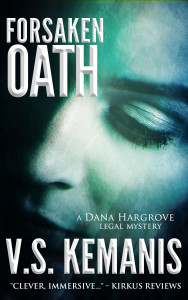 “Kirkus recently reviewed three legal thrillers that focus on resourceful attorneys pursuing justice. In V.S. Kemanis’
“Kirkus recently reviewed three legal thrillers that focus on resourceful attorneys pursuing justice. In V.S. Kemanis’ 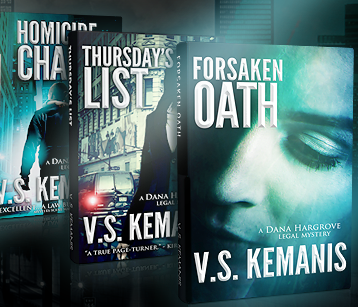
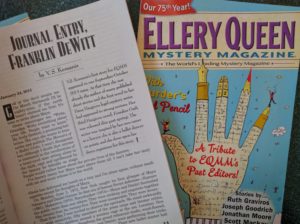
 In 2017, I look forward to completing another short fiction collection and the fourth Dana Hargrove novel!
In 2017, I look forward to completing another short fiction collection and the fourth Dana Hargrove novel!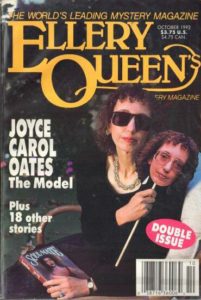
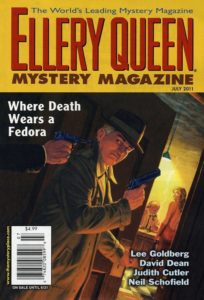 ormer managing editor of EQMM), and award-winning authors
ormer managing editor of EQMM), and award-winning authors  nt their new magazine, there could not have been any question that its outlook would be global. Both men had cosmopolitan tastes and a knowledge of world literature. It has become part of EQMM lore that Dannay, who soon took over the editing of the magazine, aimed to prove, in its pages, that every great writer in history had written at least one story that could be considered a mystery.”
nt their new magazine, there could not have been any question that its outlook would be global. Both men had cosmopolitan tastes and a knowledge of world literature. It has become part of EQMM lore that Dannay, who soon took over the editing of the magazine, aimed to prove, in its pages, that every great writer in history had written at least one story that could be considered a mystery.”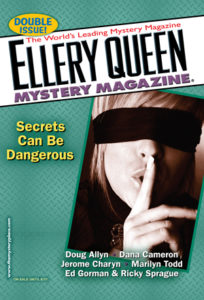 and its e-book anthology,
and its e-book anthology, 